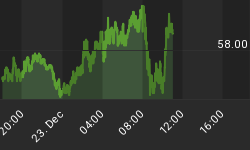The last time I looked at gold was on January 2, 2009. Gold had closed above its "simple 10 month moving average and above a down sloping trend line formed by two prior pivot high points."
I went on to state: "Typically and on a purely price action basis, I would consider this bullish. However, for gold, these technical milestones have failed to produce any meaningful edge especially when we apply other filters of the price action (such as the "next big thing" indicator). In other words, I don't believe that this represents the beginnings of a new secular up trend in gold."
This was a good "call" as gold ultimately dropped to $800 and it now rests some 3% below that week's close. The breakout was a fake out. Technically, nothing has changed with gold, and I believe it will be in trading range for many months.
The fundamentals for gold are easiest explained by the competing forces of inflation and deflation. The ultra easy monetary policies of central bankers are today's seeds that are sowing tomorrow's inflation. The global recession and popping of the commodity and housing bubbles are strong deflationary forces. That should limit the rise of gold. In essence, these fundamentals reflect how gold has performed over the past year. It was up and it was down, and in the end, it really didn't do much. However, gold easily out performed equities and other commodities.
But let's take a relative look at gold. In this instance, I am looking at the price of gold in other currencies. My motivation for this is the fact that the British Pound is hitting 23 year lows versus the US Dollar this week, which means that gold is hitting a new record high in terms of British Pounds. The currencies that I am looking at are: 1) Australian Dollar; 2) Canadian Dollar; 3) Swiss Franc; 4) Eurodollar; 5) British Pound; 6) Singaporean Dollar; 7) Japanese Yen; 8) US Dollar.
Once I determined the price of gold in these currencies, I then took a 52 week rate of change of each data series. I then combined these values into a single, composite indicator that is shown in figure 1, a weekly chart of gold.
Figure 1. Gold/ weekly
Several observations:
1) the indicator is above the zero line and this is positive;
2) in essence, when gold is rising against the majority of currencies, then the price of gold is rising;
3) the indicator is currently trending lower;
4) the series of lower highs in the indicator are noted by the "1,2,3,4" and this has been the pattern since early 2008.
In sum, with the indicator just barely above the zero line, gold is outperforming only 4 of the eight currencies measured, and as long as the indicator is above the zero line, the downside should be limited for gold. On the other hand, the indicator is trending lower, and this is not a pattern consistent with higher gold prices.
Gold's performance relative to 8 currencies is mixed. In essence, this is consistent with the competing dynamics seen with the fundamental picture. In the end, gold is likely to remain in a trading range.
















